Business Finance Report: Cash Flow Problems and Investment Appraisal
VerifiedAdded on 2020/01/28
|10
|3240
|62
Report
AI Summary
This report, designed for a small-sized business consultancy, delves into critical aspects of business finance. It differentiates between cash and profit, highlighting the importance of managing cash flow effectively to maintain liquidity. The report examines the causes of cash shortages, including low sales, excessive expenses, poor investment decisions, and economic changes, and offers solutions such as promotional strategies and budgeting. Furthermore, it outlines the capital budgeting process, including identifying opportunities, evaluating options, estimating cash flows, project selection, and implementation. The report also details key investment appraisal methods like payback period, NPV, ARR, and IRR, providing a comprehensive guide to making informed investment decisions. This analysis is crucial for businesses seeking to improve their financial management and achieve sustainable growth. The report is a valuable resource for understanding and applying core financial principles to real-world business scenarios.
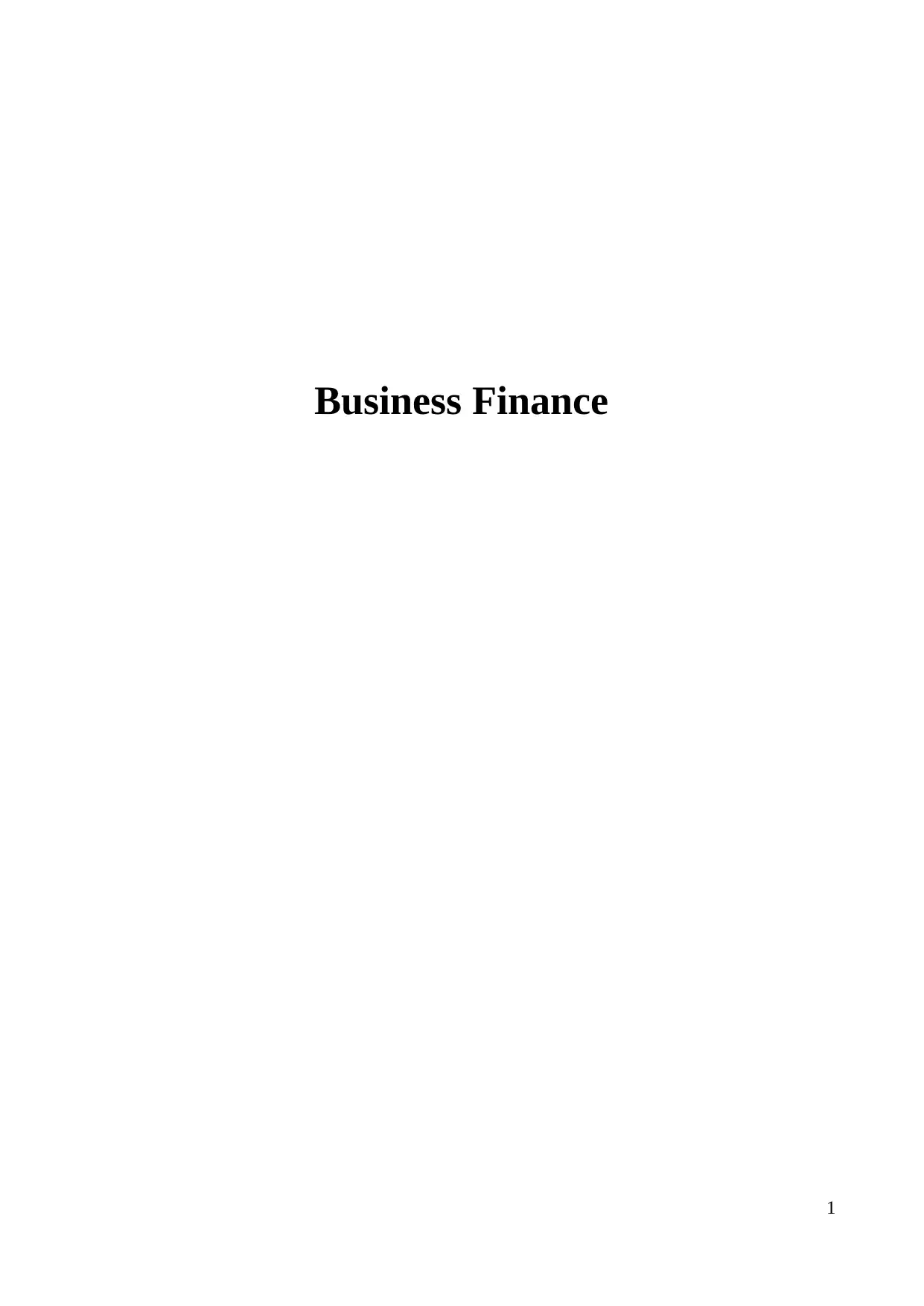
Business Finance
1
1
Paraphrase This Document
Need a fresh take? Get an instant paraphrase of this document with our AI Paraphraser
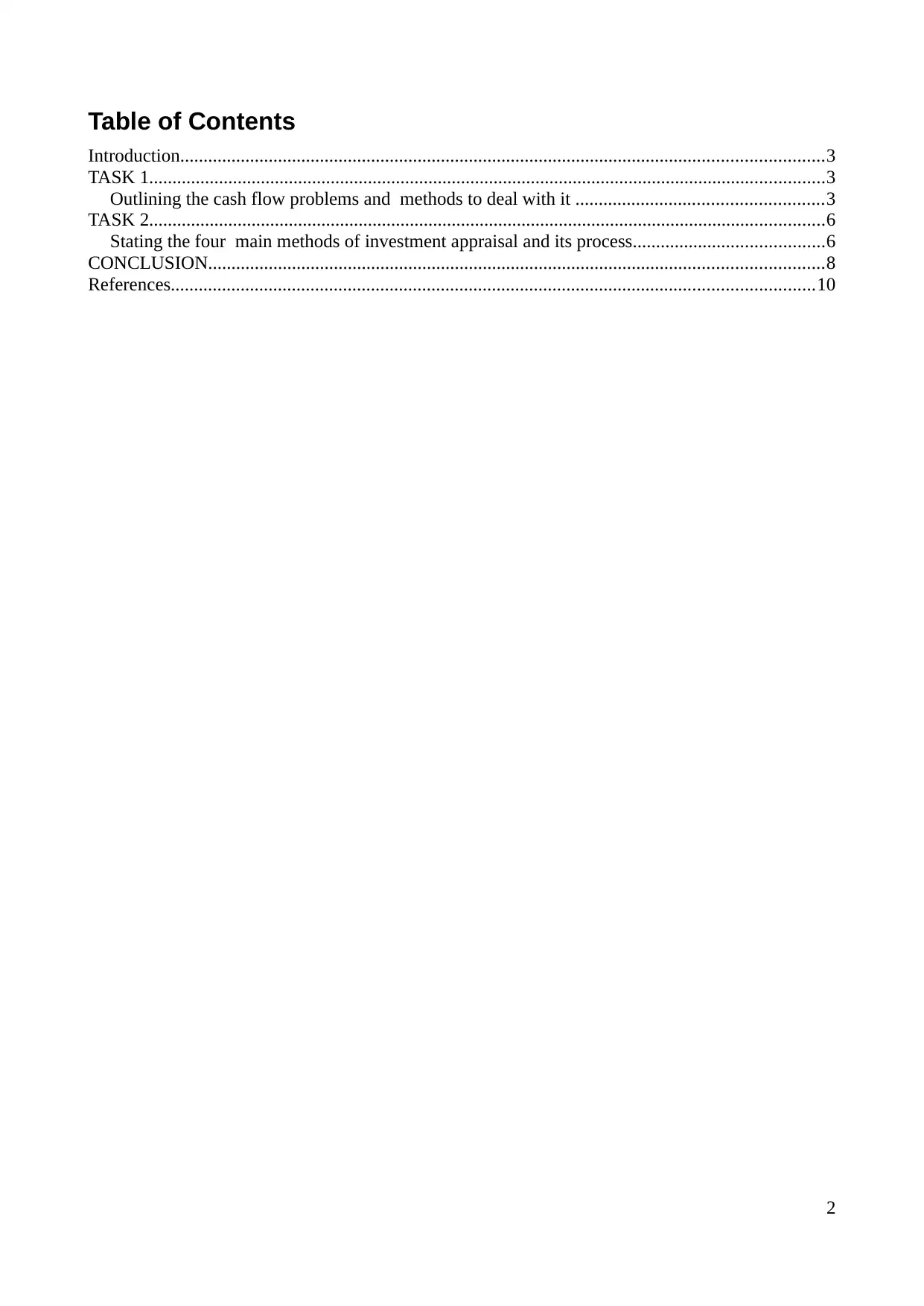
Table of Contents
Introduction..........................................................................................................................................3
TASK 1.................................................................................................................................................3
Outlining the cash flow problems and methods to deal with it .....................................................3
TASK 2.................................................................................................................................................6
Stating the four main methods of investment appraisal and its process.........................................6
CONCLUSION....................................................................................................................................8
References..........................................................................................................................................10
2
Introduction..........................................................................................................................................3
TASK 1.................................................................................................................................................3
Outlining the cash flow problems and methods to deal with it .....................................................3
TASK 2.................................................................................................................................................6
Stating the four main methods of investment appraisal and its process.........................................6
CONCLUSION....................................................................................................................................8
References..........................................................................................................................................10
2

INTRODUCTION
Business finance consists of the wide range of discipline and activities which is closely
related to the management of money. Finance is the most crucial element of the business. In this,
manager of the firm has accountability to make optimum use of financial resources. Business
finance may be defined as a process in which organization makes focus on the collection of fund
from the low cost of monetary sources. Through this, business organization is able to exert control
on the outflow of the firm to the large extent. This report is based on case scenario company offers
consultancy services to the small sized business organization. The present report will differentiate
the cash and profit. Besides this, it will also shed light on the impact of short of cash on the function
and operations of business organization. Further, it will also discuss the stages which are involved
in the capital budgeting process. It also depicts the various tools which help business unit in making
most profitable investment decisions.
TASK 1
Outlining the cash flow problems and methods to deal with it
On the basis of the cited case scenario, it is advised by the company to two clients or small
sized business organization that they need to manage their cash related activities in an effectual
manner. Moreover, cash and profit is one of the most significant factors which assists corporation in
maintaining the liquidity to the large extent. Nevertheless, cash and profit is highly different from
each other in the following manner:
Difference between the cash and profit: Cash flow includes both inflow and outflow which may
present of the outcome of the business activities. Cash inflow represents the sales revenue which is
generated by the firm during the accounting year. Whereas, outflow contains the expenses such as
salaries of the employees, office and other expenditures etc. Thus, balance of inflow and outflow
clearly presents the condition of deficit and surplus. Position of surplus reflects that company has
made optimum use of their financial resources to the significant level (Lončar, 2011). On the
contrary to it, profit reflects the revenue which is generated by the firm over the expenditures. In
income statement, business unit records all the income and expenses whether they received or
incurred in cash or not. In comparison to this, cash flow entails the income and expenditures which
are received or incurred by the firm in cash. On the basis of this aspect, it can be said that profit
includes both monetary and non-monetary transactions. Whereas, cash flow is completely based on
the cash related activities.
In addition to this, users of cash and profit statement is highly differs to the large extent.
Moreover, shareholders of the firm makes evaluation of the profitability aspect because the
3
Business finance consists of the wide range of discipline and activities which is closely
related to the management of money. Finance is the most crucial element of the business. In this,
manager of the firm has accountability to make optimum use of financial resources. Business
finance may be defined as a process in which organization makes focus on the collection of fund
from the low cost of monetary sources. Through this, business organization is able to exert control
on the outflow of the firm to the large extent. This report is based on case scenario company offers
consultancy services to the small sized business organization. The present report will differentiate
the cash and profit. Besides this, it will also shed light on the impact of short of cash on the function
and operations of business organization. Further, it will also discuss the stages which are involved
in the capital budgeting process. It also depicts the various tools which help business unit in making
most profitable investment decisions.
TASK 1
Outlining the cash flow problems and methods to deal with it
On the basis of the cited case scenario, it is advised by the company to two clients or small
sized business organization that they need to manage their cash related activities in an effectual
manner. Moreover, cash and profit is one of the most significant factors which assists corporation in
maintaining the liquidity to the large extent. Nevertheless, cash and profit is highly different from
each other in the following manner:
Difference between the cash and profit: Cash flow includes both inflow and outflow which may
present of the outcome of the business activities. Cash inflow represents the sales revenue which is
generated by the firm during the accounting year. Whereas, outflow contains the expenses such as
salaries of the employees, office and other expenditures etc. Thus, balance of inflow and outflow
clearly presents the condition of deficit and surplus. Position of surplus reflects that company has
made optimum use of their financial resources to the significant level (Lončar, 2011). On the
contrary to it, profit reflects the revenue which is generated by the firm over the expenditures. In
income statement, business unit records all the income and expenses whether they received or
incurred in cash or not. In comparison to this, cash flow entails the income and expenditures which
are received or incurred by the firm in cash. On the basis of this aspect, it can be said that profit
includes both monetary and non-monetary transactions. Whereas, cash flow is completely based on
the cash related activities.
In addition to this, users of cash and profit statement is highly differs to the large extent.
Moreover, shareholders of the firm makes evaluation of the profitability aspect because the
3
⊘ This is a preview!⊘
Do you want full access?
Subscribe today to unlock all pages.

Trusted by 1+ million students worldwide
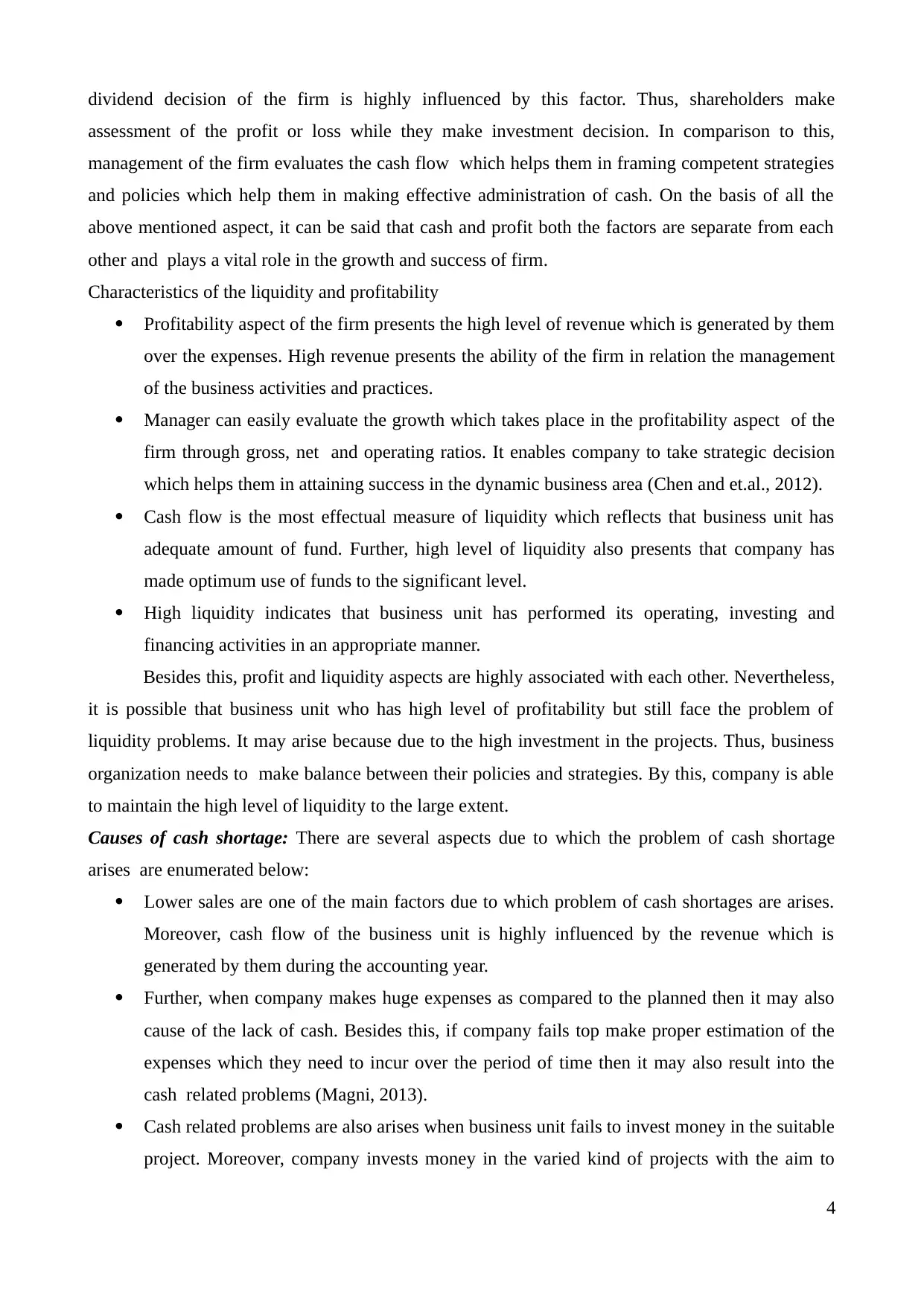
dividend decision of the firm is highly influenced by this factor. Thus, shareholders make
assessment of the profit or loss while they make investment decision. In comparison to this,
management of the firm evaluates the cash flow which helps them in framing competent strategies
and policies which help them in making effective administration of cash. On the basis of all the
above mentioned aspect, it can be said that cash and profit both the factors are separate from each
other and plays a vital role in the growth and success of firm.
Characteristics of the liquidity and profitability
Profitability aspect of the firm presents the high level of revenue which is generated by them
over the expenses. High revenue presents the ability of the firm in relation the management
of the business activities and practices.
Manager can easily evaluate the growth which takes place in the profitability aspect of the
firm through gross, net and operating ratios. It enables company to take strategic decision
which helps them in attaining success in the dynamic business area (Chen and et.al., 2012).
Cash flow is the most effectual measure of liquidity which reflects that business unit has
adequate amount of fund. Further, high level of liquidity also presents that company has
made optimum use of funds to the significant level.
High liquidity indicates that business unit has performed its operating, investing and
financing activities in an appropriate manner.
Besides this, profit and liquidity aspects are highly associated with each other. Nevertheless,
it is possible that business unit who has high level of profitability but still face the problem of
liquidity problems. It may arise because due to the high investment in the projects. Thus, business
organization needs to make balance between their policies and strategies. By this, company is able
to maintain the high level of liquidity to the large extent.
Causes of cash shortage: There are several aspects due to which the problem of cash shortage
arises are enumerated below:
Lower sales are one of the main factors due to which problem of cash shortages are arises.
Moreover, cash flow of the business unit is highly influenced by the revenue which is
generated by them during the accounting year.
Further, when company makes huge expenses as compared to the planned then it may also
cause of the lack of cash. Besides this, if company fails top make proper estimation of the
expenses which they need to incur over the period of time then it may also result into the
cash related problems (Magni, 2013).
Cash related problems are also arises when business unit fails to invest money in the suitable
project. Moreover, company invests money in the varied kind of projects with the aim to
4
assessment of the profit or loss while they make investment decision. In comparison to this,
management of the firm evaluates the cash flow which helps them in framing competent strategies
and policies which help them in making effective administration of cash. On the basis of all the
above mentioned aspect, it can be said that cash and profit both the factors are separate from each
other and plays a vital role in the growth and success of firm.
Characteristics of the liquidity and profitability
Profitability aspect of the firm presents the high level of revenue which is generated by them
over the expenses. High revenue presents the ability of the firm in relation the management
of the business activities and practices.
Manager can easily evaluate the growth which takes place in the profitability aspect of the
firm through gross, net and operating ratios. It enables company to take strategic decision
which helps them in attaining success in the dynamic business area (Chen and et.al., 2012).
Cash flow is the most effectual measure of liquidity which reflects that business unit has
adequate amount of fund. Further, high level of liquidity also presents that company has
made optimum use of funds to the significant level.
High liquidity indicates that business unit has performed its operating, investing and
financing activities in an appropriate manner.
Besides this, profit and liquidity aspects are highly associated with each other. Nevertheless,
it is possible that business unit who has high level of profitability but still face the problem of
liquidity problems. It may arise because due to the high investment in the projects. Thus, business
organization needs to make balance between their policies and strategies. By this, company is able
to maintain the high level of liquidity to the large extent.
Causes of cash shortage: There are several aspects due to which the problem of cash shortage
arises are enumerated below:
Lower sales are one of the main factors due to which problem of cash shortages are arises.
Moreover, cash flow of the business unit is highly influenced by the revenue which is
generated by them during the accounting year.
Further, when company makes huge expenses as compared to the planned then it may also
cause of the lack of cash. Besides this, if company fails top make proper estimation of the
expenses which they need to incur over the period of time then it may also result into the
cash related problems (Magni, 2013).
Cash related problems are also arises when business unit fails to invest money in the suitable
project. Moreover, company invests money in the varied kind of projects with the aim to
4
Paraphrase This Document
Need a fresh take? Get an instant paraphrase of this document with our AI Paraphraser
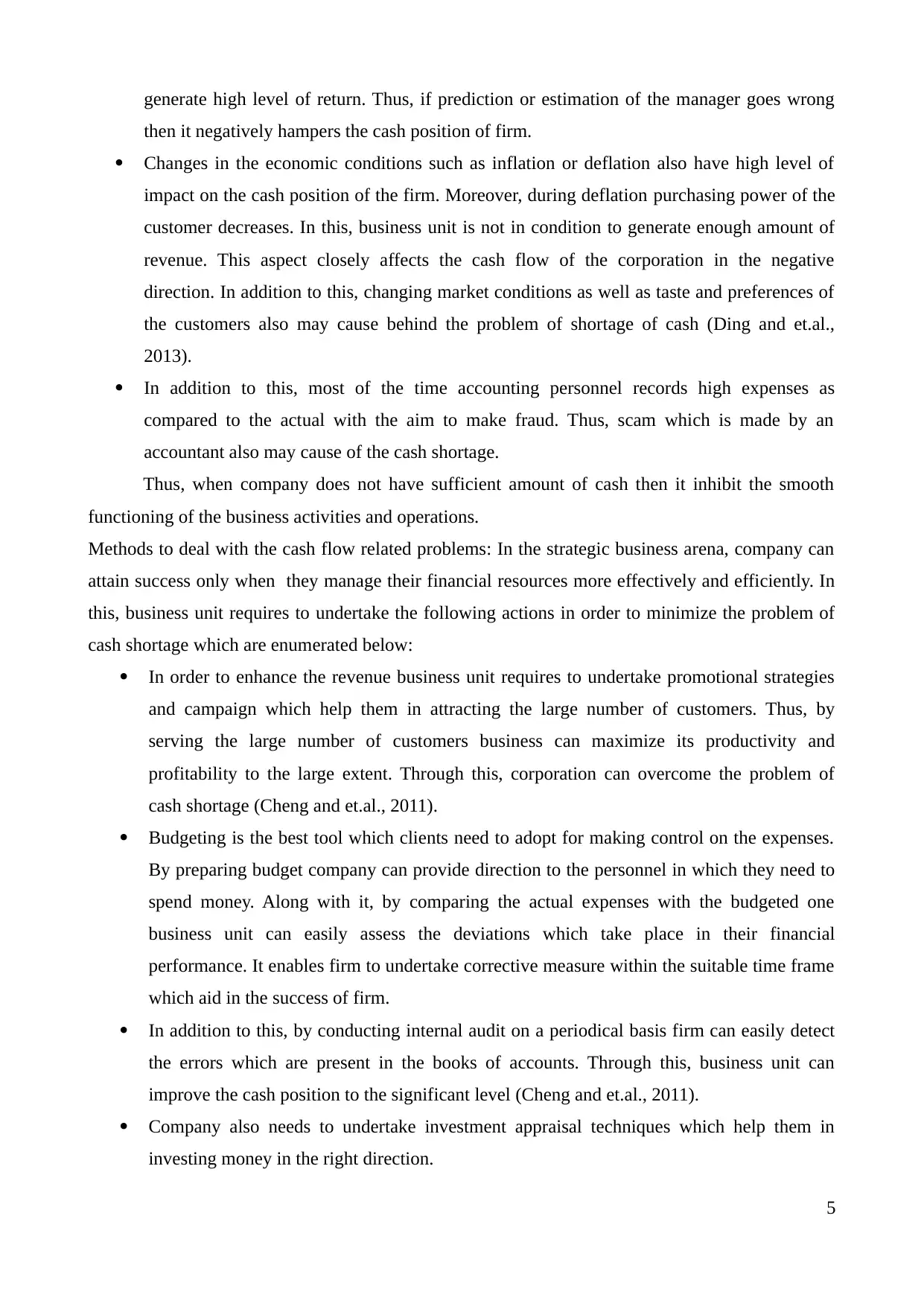
generate high level of return. Thus, if prediction or estimation of the manager goes wrong
then it negatively hampers the cash position of firm.
Changes in the economic conditions such as inflation or deflation also have high level of
impact on the cash position of the firm. Moreover, during deflation purchasing power of the
customer decreases. In this, business unit is not in condition to generate enough amount of
revenue. This aspect closely affects the cash flow of the corporation in the negative
direction. In addition to this, changing market conditions as well as taste and preferences of
the customers also may cause behind the problem of shortage of cash (Ding and et.al.,
2013).
In addition to this, most of the time accounting personnel records high expenses as
compared to the actual with the aim to make fraud. Thus, scam which is made by an
accountant also may cause of the cash shortage.
Thus, when company does not have sufficient amount of cash then it inhibit the smooth
functioning of the business activities and operations.
Methods to deal with the cash flow related problems: In the strategic business arena, company can
attain success only when they manage their financial resources more effectively and efficiently. In
this, business unit requires to undertake the following actions in order to minimize the problem of
cash shortage which are enumerated below:
In order to enhance the revenue business unit requires to undertake promotional strategies
and campaign which help them in attracting the large number of customers. Thus, by
serving the large number of customers business can maximize its productivity and
profitability to the large extent. Through this, corporation can overcome the problem of
cash shortage (Cheng and et.al., 2011).
Budgeting is the best tool which clients need to adopt for making control on the expenses.
By preparing budget company can provide direction to the personnel in which they need to
spend money. Along with it, by comparing the actual expenses with the budgeted one
business unit can easily assess the deviations which take place in their financial
performance. It enables firm to undertake corrective measure within the suitable time frame
which aid in the success of firm.
In addition to this, by conducting internal audit on a periodical basis firm can easily detect
the errors which are present in the books of accounts. Through this, business unit can
improve the cash position to the significant level (Cheng and et.al., 2011).
Company also needs to undertake investment appraisal techniques which help them in
investing money in the right direction.
5
then it negatively hampers the cash position of firm.
Changes in the economic conditions such as inflation or deflation also have high level of
impact on the cash position of the firm. Moreover, during deflation purchasing power of the
customer decreases. In this, business unit is not in condition to generate enough amount of
revenue. This aspect closely affects the cash flow of the corporation in the negative
direction. In addition to this, changing market conditions as well as taste and preferences of
the customers also may cause behind the problem of shortage of cash (Ding and et.al.,
2013).
In addition to this, most of the time accounting personnel records high expenses as
compared to the actual with the aim to make fraud. Thus, scam which is made by an
accountant also may cause of the cash shortage.
Thus, when company does not have sufficient amount of cash then it inhibit the smooth
functioning of the business activities and operations.
Methods to deal with the cash flow related problems: In the strategic business arena, company can
attain success only when they manage their financial resources more effectively and efficiently. In
this, business unit requires to undertake the following actions in order to minimize the problem of
cash shortage which are enumerated below:
In order to enhance the revenue business unit requires to undertake promotional strategies
and campaign which help them in attracting the large number of customers. Thus, by
serving the large number of customers business can maximize its productivity and
profitability to the large extent. Through this, corporation can overcome the problem of
cash shortage (Cheng and et.al., 2011).
Budgeting is the best tool which clients need to adopt for making control on the expenses.
By preparing budget company can provide direction to the personnel in which they need to
spend money. Along with it, by comparing the actual expenses with the budgeted one
business unit can easily assess the deviations which take place in their financial
performance. It enables firm to undertake corrective measure within the suitable time frame
which aid in the success of firm.
In addition to this, by conducting internal audit on a periodical basis firm can easily detect
the errors which are present in the books of accounts. Through this, business unit can
improve the cash position to the significant level (Cheng and et.al., 2011).
Company also needs to undertake investment appraisal techniques which help them in
investing money in the right direction.
5

Thus, all the above mentioned aspect provide high level of assistance to the firm in
managing cash in the best possible manner.
TASK 2
Stating the four main methods of investment appraisal and its process
Capital budgeting: It may be served as financial or planning tool that assists in evaluating and
ranking the potential investment. By this, personnel of the client assess the profitability and viability
of the proposed investment in an effectual manner.
Process of capital budgeting: It involve five stages which will helps small sized business
organization in evaluating the profitability and worthiness of project. Thus, b taking into account
the following steps manager of two clients are become able to make suitable investment decision. Identification of potential opportunities: In the very first step of capital budgeting, clients
need to make assessment of all the investment opportunities which is available to them.
Moreover, in the present era there are lots of investment opportunities are available to the
business enterprise. In this, manager of the firm needs to identify all the investment option
which proves to be more beneficial for it (Libby and et.al., 2010). Evaluation of the investment options: Once opportunities have identified thereafter
manager of the firm needs to evaluate all the investment option which are highly suite d to
their vision and mission. Moreover, it is not possible for the firm to invest money in all the
project. Thus, manager makes evaluation of the option to determine the extent to which it is
highly realistic in the present time (Advantage and disadvantage of capital budgeting tools,
2016). Estimating the cash flows of benefits: At this stage, manager estimates the cash flow which
they will get by investing money in the particular project. Moreover, growth and success of
the firm is highly dependent on profitability which is earned by them. By keeping this fact in
mind investment manager undertakes several capital budgeting tools and technique. Payback
period, NPV, ARR and IRR are the most effectual techniques which help business
organization in making suitable decision (Libby and et.al., 2010). Selection of the project: In this, personnel makes evaluation of the viability of project on the
basis of the outcomes of different tools or techniques. Thus, in payback period business unit
needs to select the option which have less duration. On the basis of this, company is able is
able to recover the amount within the short span of time. On the contrary to it, in NPV,
ARR and IRR client needs to select the project which offer them high return after the
6
managing cash in the best possible manner.
TASK 2
Stating the four main methods of investment appraisal and its process
Capital budgeting: It may be served as financial or planning tool that assists in evaluating and
ranking the potential investment. By this, personnel of the client assess the profitability and viability
of the proposed investment in an effectual manner.
Process of capital budgeting: It involve five stages which will helps small sized business
organization in evaluating the profitability and worthiness of project. Thus, b taking into account
the following steps manager of two clients are become able to make suitable investment decision. Identification of potential opportunities: In the very first step of capital budgeting, clients
need to make assessment of all the investment opportunities which is available to them.
Moreover, in the present era there are lots of investment opportunities are available to the
business enterprise. In this, manager of the firm needs to identify all the investment option
which proves to be more beneficial for it (Libby and et.al., 2010). Evaluation of the investment options: Once opportunities have identified thereafter
manager of the firm needs to evaluate all the investment option which are highly suite d to
their vision and mission. Moreover, it is not possible for the firm to invest money in all the
project. Thus, manager makes evaluation of the option to determine the extent to which it is
highly realistic in the present time (Advantage and disadvantage of capital budgeting tools,
2016). Estimating the cash flows of benefits: At this stage, manager estimates the cash flow which
they will get by investing money in the particular project. Moreover, growth and success of
the firm is highly dependent on profitability which is earned by them. By keeping this fact in
mind investment manager undertakes several capital budgeting tools and technique. Payback
period, NPV, ARR and IRR are the most effectual techniques which help business
organization in making suitable decision (Libby and et.al., 2010). Selection of the project: In this, personnel makes evaluation of the viability of project on the
basis of the outcomes of different tools or techniques. Thus, in payback period business unit
needs to select the option which have less duration. On the basis of this, company is able is
able to recover the amount within the short span of time. On the contrary to it, in NPV,
ARR and IRR client needs to select the project which offer them high return after the
6
⊘ This is a preview!⊘
Do you want full access?
Subscribe today to unlock all pages.

Trusted by 1+ million students worldwide
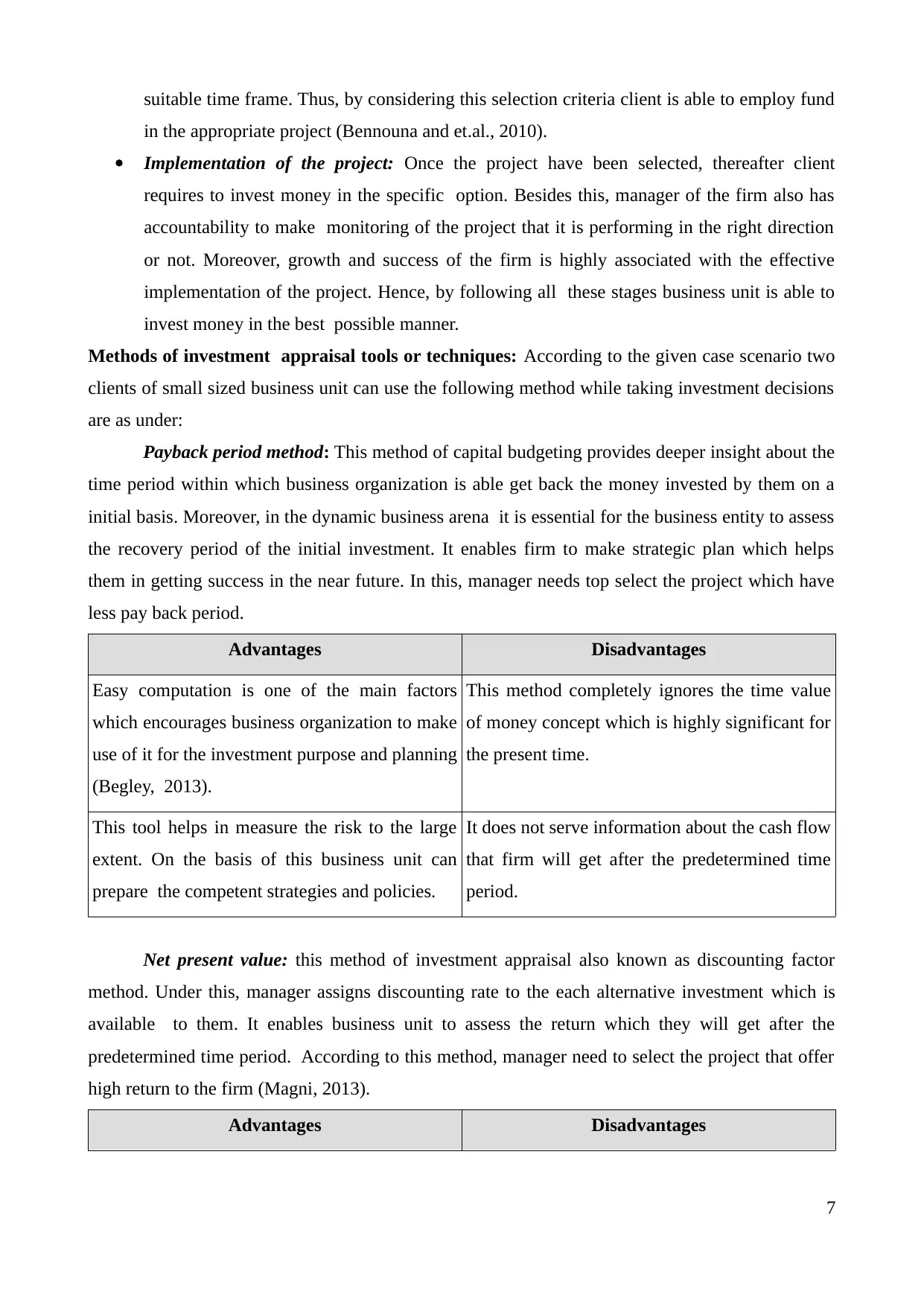
suitable time frame. Thus, by considering this selection criteria client is able to employ fund
in the appropriate project (Bennouna and et.al., 2010).
Implementation of the project: Once the project have been selected, thereafter client
requires to invest money in the specific option. Besides this, manager of the firm also has
accountability to make monitoring of the project that it is performing in the right direction
or not. Moreover, growth and success of the firm is highly associated with the effective
implementation of the project. Hence, by following all these stages business unit is able to
invest money in the best possible manner.
Methods of investment appraisal tools or techniques: According to the given case scenario two
clients of small sized business unit can use the following method while taking investment decisions
are as under:
Payback period method: This method of capital budgeting provides deeper insight about the
time period within which business organization is able get back the money invested by them on a
initial basis. Moreover, in the dynamic business arena it is essential for the business entity to assess
the recovery period of the initial investment. It enables firm to make strategic plan which helps
them in getting success in the near future. In this, manager needs top select the project which have
less pay back period.
Advantages Disadvantages
Easy computation is one of the main factors
which encourages business organization to make
use of it for the investment purpose and planning
(Begley, 2013).
This method completely ignores the time value
of money concept which is highly significant for
the present time.
This tool helps in measure the risk to the large
extent. On the basis of this business unit can
prepare the competent strategies and policies.
It does not serve information about the cash flow
that firm will get after the predetermined time
period.
Net present value: this method of investment appraisal also known as discounting factor
method. Under this, manager assigns discounting rate to the each alternative investment which is
available to them. It enables business unit to assess the return which they will get after the
predetermined time period. According to this method, manager need to select the project that offer
high return to the firm (Magni, 2013).
Advantages Disadvantages
7
in the appropriate project (Bennouna and et.al., 2010).
Implementation of the project: Once the project have been selected, thereafter client
requires to invest money in the specific option. Besides this, manager of the firm also has
accountability to make monitoring of the project that it is performing in the right direction
or not. Moreover, growth and success of the firm is highly associated with the effective
implementation of the project. Hence, by following all these stages business unit is able to
invest money in the best possible manner.
Methods of investment appraisal tools or techniques: According to the given case scenario two
clients of small sized business unit can use the following method while taking investment decisions
are as under:
Payback period method: This method of capital budgeting provides deeper insight about the
time period within which business organization is able get back the money invested by them on a
initial basis. Moreover, in the dynamic business arena it is essential for the business entity to assess
the recovery period of the initial investment. It enables firm to make strategic plan which helps
them in getting success in the near future. In this, manager needs top select the project which have
less pay back period.
Advantages Disadvantages
Easy computation is one of the main factors
which encourages business organization to make
use of it for the investment purpose and planning
(Begley, 2013).
This method completely ignores the time value
of money concept which is highly significant for
the present time.
This tool helps in measure the risk to the large
extent. On the basis of this business unit can
prepare the competent strategies and policies.
It does not serve information about the cash flow
that firm will get after the predetermined time
period.
Net present value: this method of investment appraisal also known as discounting factor
method. Under this, manager assigns discounting rate to the each alternative investment which is
available to them. It enables business unit to assess the return which they will get after the
predetermined time period. According to this method, manager need to select the project that offer
high return to the firm (Magni, 2013).
Advantages Disadvantages
7
Paraphrase This Document
Need a fresh take? Get an instant paraphrase of this document with our AI Paraphraser
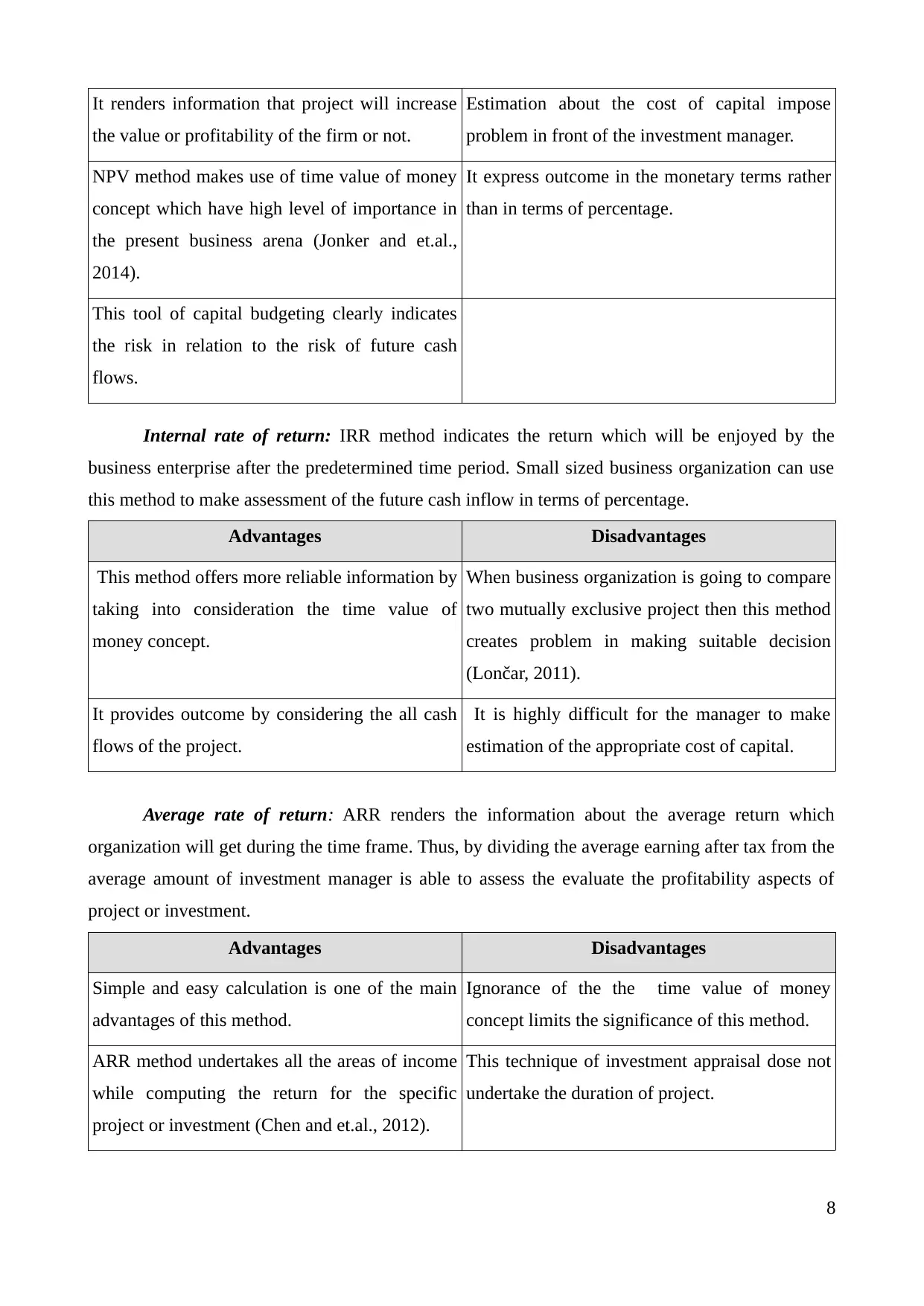
It renders information that project will increase
the value or profitability of the firm or not.
Estimation about the cost of capital impose
problem in front of the investment manager.
NPV method makes use of time value of money
concept which have high level of importance in
the present business arena (Jonker and et.al.,
2014).
It express outcome in the monetary terms rather
than in terms of percentage.
This tool of capital budgeting clearly indicates
the risk in relation to the risk of future cash
flows.
Internal rate of return: IRR method indicates the return which will be enjoyed by the
business enterprise after the predetermined time period. Small sized business organization can use
this method to make assessment of the future cash inflow in terms of percentage.
Advantages Disadvantages
This method offers more reliable information by
taking into consideration the time value of
money concept.
When business organization is going to compare
two mutually exclusive project then this method
creates problem in making suitable decision
(Lončar, 2011).
It provides outcome by considering the all cash
flows of the project.
It is highly difficult for the manager to make
estimation of the appropriate cost of capital.
Average rate of return: ARR renders the information about the average return which
organization will get during the time frame. Thus, by dividing the average earning after tax from the
average amount of investment manager is able to assess the evaluate the profitability aspects of
project or investment.
Advantages Disadvantages
Simple and easy calculation is one of the main
advantages of this method.
Ignorance of the the time value of money
concept limits the significance of this method.
ARR method undertakes all the areas of income
while computing the return for the specific
project or investment (Chen and et.al., 2012).
This technique of investment appraisal dose not
undertake the duration of project.
8
the value or profitability of the firm or not.
Estimation about the cost of capital impose
problem in front of the investment manager.
NPV method makes use of time value of money
concept which have high level of importance in
the present business arena (Jonker and et.al.,
2014).
It express outcome in the monetary terms rather
than in terms of percentage.
This tool of capital budgeting clearly indicates
the risk in relation to the risk of future cash
flows.
Internal rate of return: IRR method indicates the return which will be enjoyed by the
business enterprise after the predetermined time period. Small sized business organization can use
this method to make assessment of the future cash inflow in terms of percentage.
Advantages Disadvantages
This method offers more reliable information by
taking into consideration the time value of
money concept.
When business organization is going to compare
two mutually exclusive project then this method
creates problem in making suitable decision
(Lončar, 2011).
It provides outcome by considering the all cash
flows of the project.
It is highly difficult for the manager to make
estimation of the appropriate cost of capital.
Average rate of return: ARR renders the information about the average return which
organization will get during the time frame. Thus, by dividing the average earning after tax from the
average amount of investment manager is able to assess the evaluate the profitability aspects of
project or investment.
Advantages Disadvantages
Simple and easy calculation is one of the main
advantages of this method.
Ignorance of the the time value of money
concept limits the significance of this method.
ARR method undertakes all the areas of income
while computing the return for the specific
project or investment (Chen and et.al., 2012).
This technique of investment appraisal dose not
undertake the duration of project.
8
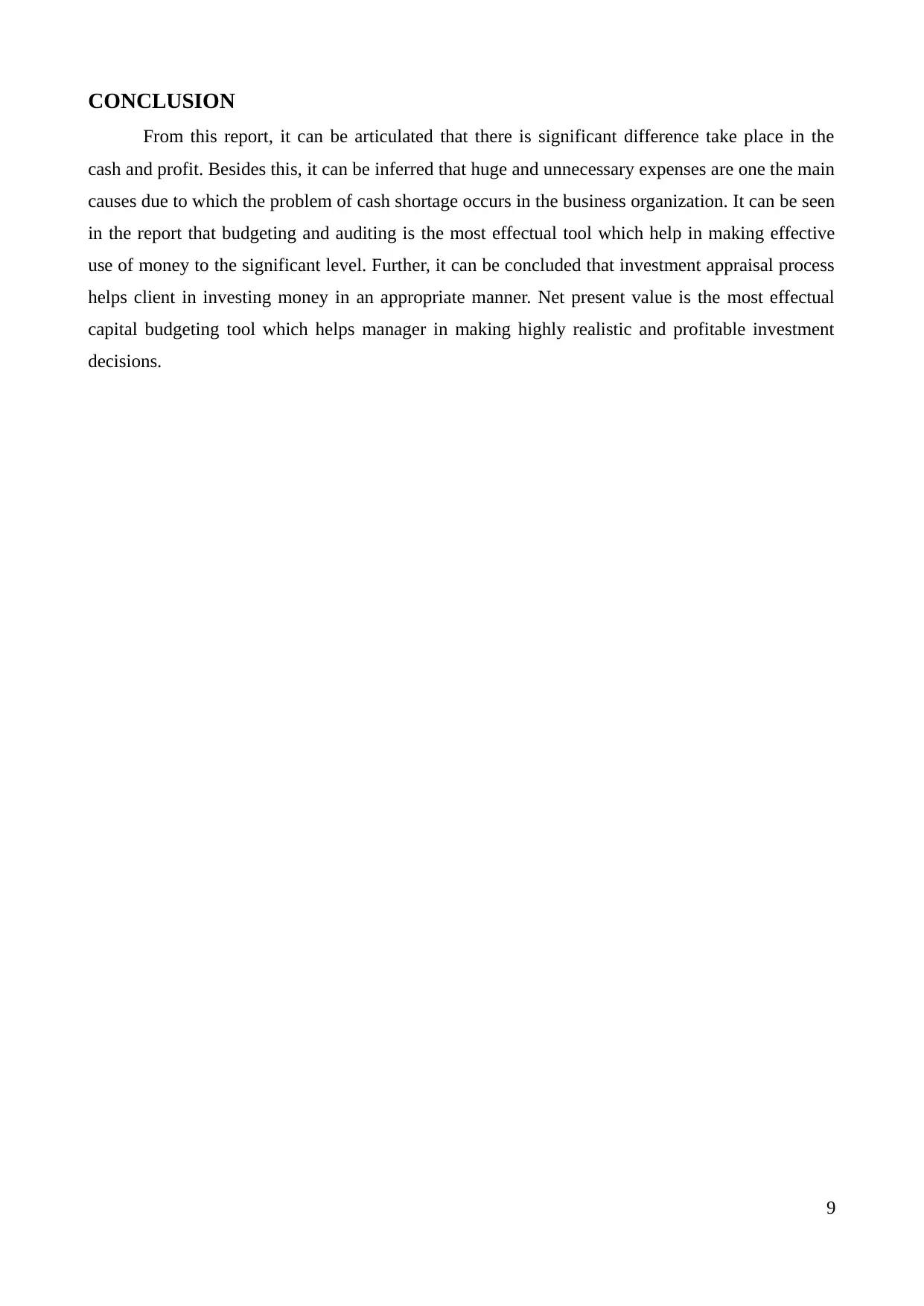
CONCLUSION
From this report, it can be articulated that there is significant difference take place in the
cash and profit. Besides this, it can be inferred that huge and unnecessary expenses are one the main
causes due to which the problem of cash shortage occurs in the business organization. It can be seen
in the report that budgeting and auditing is the most effectual tool which help in making effective
use of money to the significant level. Further, it can be concluded that investment appraisal process
helps client in investing money in an appropriate manner. Net present value is the most effectual
capital budgeting tool which helps manager in making highly realistic and profitable investment
decisions.
9
From this report, it can be articulated that there is significant difference take place in the
cash and profit. Besides this, it can be inferred that huge and unnecessary expenses are one the main
causes due to which the problem of cash shortage occurs in the business organization. It can be seen
in the report that budgeting and auditing is the most effectual tool which help in making effective
use of money to the significant level. Further, it can be concluded that investment appraisal process
helps client in investing money in an appropriate manner. Net present value is the most effectual
capital budgeting tool which helps manager in making highly realistic and profitable investment
decisions.
9
⊘ This is a preview!⊘
Do you want full access?
Subscribe today to unlock all pages.

Trusted by 1+ million students worldwide
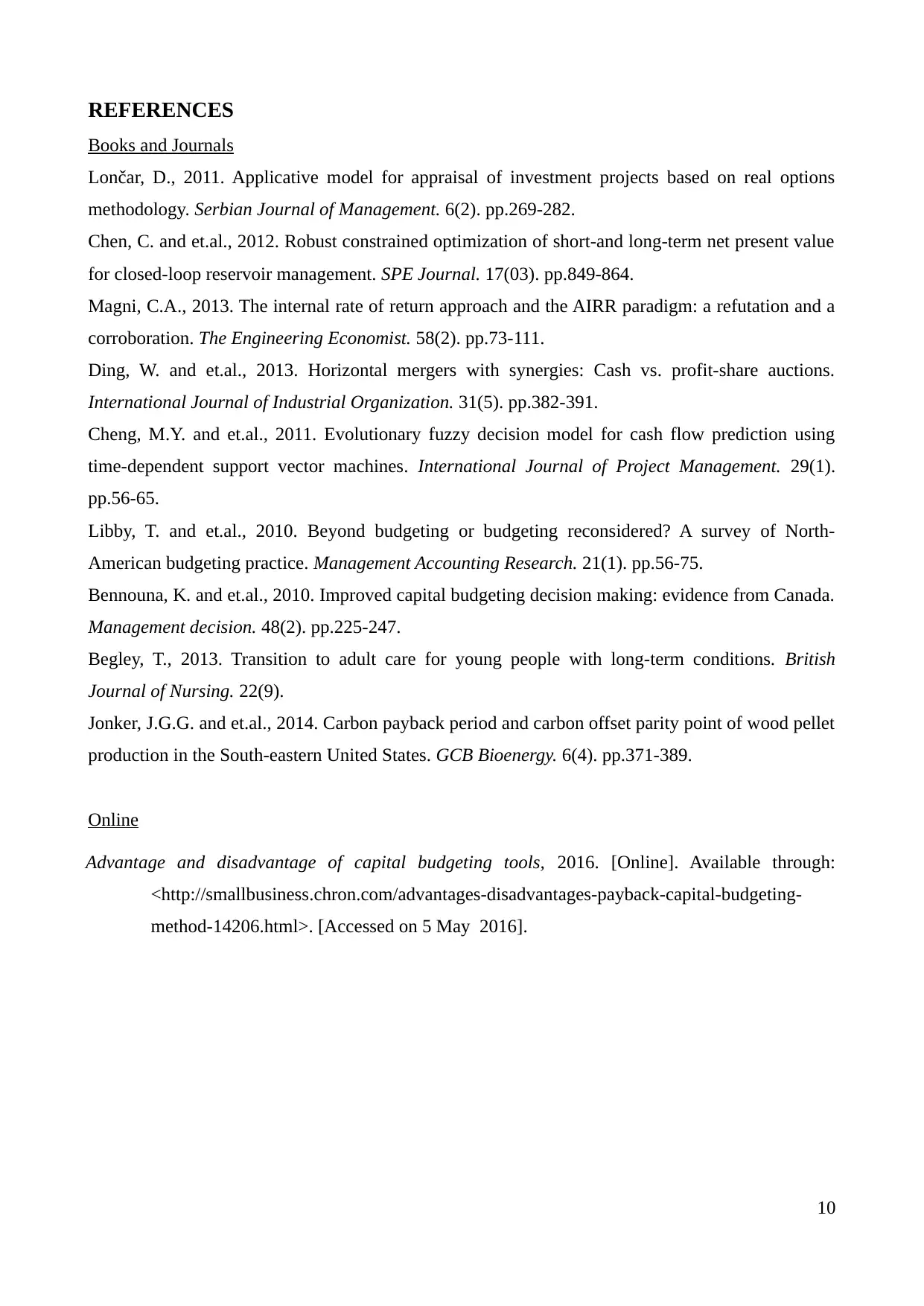
REFERENCES
Books and Journals
Lončar, D., 2011. Applicative model for appraisal of investment projects based on real options
methodology. Serbian Journal of Management. 6(2). pp.269-282.
Chen, C. and et.al., 2012. Robust constrained optimization of short-and long-term net present value
for closed-loop reservoir management. SPE Journal. 17(03). pp.849-864.
Magni, C.A., 2013. The internal rate of return approach and the AIRR paradigm: a refutation and a
corroboration. The Engineering Economist. 58(2). pp.73-111.
Ding, W. and et.al., 2013. Horizontal mergers with synergies: Cash vs. profit-share auctions.
International Journal of Industrial Organization. 31(5). pp.382-391.
Cheng, M.Y. and et.al., 2011. Evolutionary fuzzy decision model for cash flow prediction using
time-dependent support vector machines. International Journal of Project Management. 29(1).
pp.56-65.
Libby, T. and et.al., 2010. Beyond budgeting or budgeting reconsidered? A survey of North-
American budgeting practice. Management Accounting Research. 21(1). pp.56-75.
Bennouna, K. and et.al., 2010. Improved capital budgeting decision making: evidence from Canada.
Management decision. 48(2). pp.225-247.
Begley, T., 2013. Transition to adult care for young people with long-term conditions. British
Journal of Nursing. 22(9).
Jonker, J.G.G. and et.al., 2014. Carbon payback period and carbon offset parity point of wood pellet
production in the South‐eastern United States. GCB Bioenergy. 6(4). pp.371-389.
Online
Advantage and disadvantage of capital budgeting tools, 2016. [Online]. Available through:
<http://smallbusiness.chron.com/advantages-disadvantages-payback-capital-budgeting-
method-14206.html>. [Accessed on 5 May 2016].
10
Books and Journals
Lončar, D., 2011. Applicative model for appraisal of investment projects based on real options
methodology. Serbian Journal of Management. 6(2). pp.269-282.
Chen, C. and et.al., 2012. Robust constrained optimization of short-and long-term net present value
for closed-loop reservoir management. SPE Journal. 17(03). pp.849-864.
Magni, C.A., 2013. The internal rate of return approach and the AIRR paradigm: a refutation and a
corroboration. The Engineering Economist. 58(2). pp.73-111.
Ding, W. and et.al., 2013. Horizontal mergers with synergies: Cash vs. profit-share auctions.
International Journal of Industrial Organization. 31(5). pp.382-391.
Cheng, M.Y. and et.al., 2011. Evolutionary fuzzy decision model for cash flow prediction using
time-dependent support vector machines. International Journal of Project Management. 29(1).
pp.56-65.
Libby, T. and et.al., 2010. Beyond budgeting or budgeting reconsidered? A survey of North-
American budgeting practice. Management Accounting Research. 21(1). pp.56-75.
Bennouna, K. and et.al., 2010. Improved capital budgeting decision making: evidence from Canada.
Management decision. 48(2). pp.225-247.
Begley, T., 2013. Transition to adult care for young people with long-term conditions. British
Journal of Nursing. 22(9).
Jonker, J.G.G. and et.al., 2014. Carbon payback period and carbon offset parity point of wood pellet
production in the South‐eastern United States. GCB Bioenergy. 6(4). pp.371-389.
Online
Advantage and disadvantage of capital budgeting tools, 2016. [Online]. Available through:
<http://smallbusiness.chron.com/advantages-disadvantages-payback-capital-budgeting-
method-14206.html>. [Accessed on 5 May 2016].
10
1 out of 10
Related Documents
Your All-in-One AI-Powered Toolkit for Academic Success.
+13062052269
info@desklib.com
Available 24*7 on WhatsApp / Email
![[object Object]](/_next/static/media/star-bottom.7253800d.svg)
Unlock your academic potential
Copyright © 2020–2025 A2Z Services. All Rights Reserved. Developed and managed by ZUCOL.





